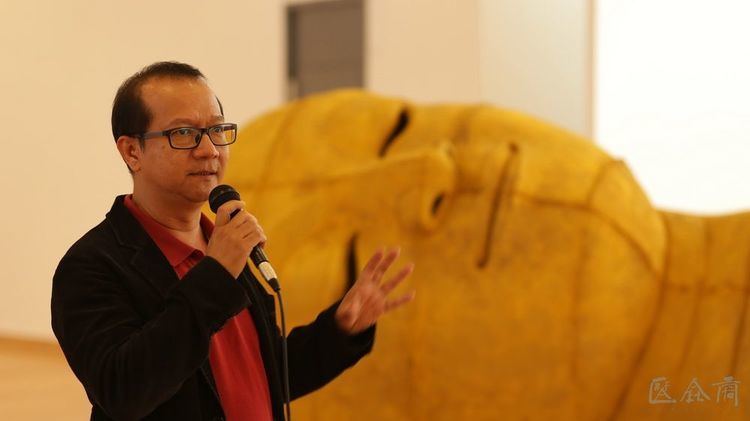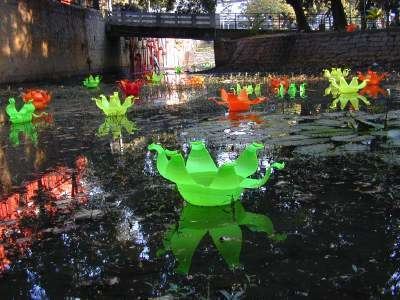Name Sakarin Krue-On | Role Artist | |
 | ||
Awards Silpathorn Award for Visual Arts | ||
Bacc exhibition imply reply huang yong ping and sakarin krue on monkeys in the house remain
Sakarin Krue-On (January 7, 1965) is a contemporary Thai visual artist. His works are often site-specific installations with traditional Thai cultural influences. Krue-On is an art instructor, an advisor for postgraduate students, and the Associate Dean of the Faculty of Painting, Sculpture and Graphic Arts at Silpakorn University. Krue-On resides and works in the metropolitan area of Bangkok, although his projects and exhibitions frequently take him out of Thailand.
Contents
- Bacc exhibition imply reply huang yong ping and sakarin krue on monkeys in the house remain
- Artscenetv net sakarin krue on
- Early life and education
- Career
- Temple 2000
- Cloud Nine Lom lom Lang lang 2005
- Terraced Rice Field 2007
- Venice Biennale 2009
- Busan Biennale 2012
- References

Artscenetv net sakarin krue on
Early life and education

Krue-On was born in Mae Hong Sorn, a northwestern Thai province. He earned his Bachelor of Fine Arts degree at Silpakorn University in 1989, under the supervision of Chalood Nimsamer.
Career

Krue-On has created a number of solo works, in addition to collaborating with other artists and presenting exhibitions at galleries and institutions. He specializes in site-specific installations, and sometimes works with local communities to produce his works. His pieces are often sculptural, but he also uses video and paintings. His work highlights the virtues of traditional Thai culture, such as rice farming practices, temple paintings, and Buddhist imagery, while blending Western and local techniques of printmaking, drawing, sculpting, and painting.

In 2009, Krue-On was the recipient of the Silpathorn Award for the category of visual arts, presented by the Office of Contemporary Art and Culture. In 2016 he won Prudential Eye Lifetime Achievement Award which made in recognition of an artist with an international track record for his or her contributions to the field of Asian contemporary art over the course of a lifetime. In addition to the award, Niru Ratnam, Director of Prudential Eye Programme citing his work as "Whilst other successful Asian artists have sited their practice within a global language of contemporary practice, Krue-On continues to work through nuances specific to Asian cultural identity. For this, and for his international success, he is the winner of the Lifetime Achievement Award at the third Prudential Eye Awards."
Temple, 2000
"Temple" was the first solo work by Krue-On, exhibited in a café and gallery, About Art Related Activities (AARA) in Bangkok. In this work, he transformed three different rooms of the gallery area into spaces for meditation, drawing influences from traditional Thai mural painting. The stencils took the forms of traditional Thai (not Buddhist) deities. The designs on the walls were created to fade over time, slowly becoming invisible. The work coincided with an economic crisis in Thailand. The artist created a similar installation, "Nang Fa (Angel)" in 2007 for the Neue Gallerie in Kassel, Germany.
Cloud Nine (Lom lom Lang lang), 2005
"Cloud Nine (Lom lom Lang lang)" was installed in the 100 Tonson gallery in Bangkok. The Thai part of the name means "empty hope." The project was a two-room installation; one room featured many white porcelain figurines of street dogs with feathery red angelic wings, devouring a banquet. The second room displayed video footage of real puppies in feeding from their mother.
Terraced Rice Field, 2007
"Terraced Rice Field" was created for Documenta 12 outside of the Schloss Wilhelmshöhe museum building. With the help of local volunteers, Krue-On created a functioning terraced rice field on the side of the nearby hill.
Venice Biennale, 2009
Krue-On was one of five artists from Bangkok who worked together to represent Thailand at the Venice Biennale in 2003 and again in 2009. In They changed a pavilion into a satirical version of a tourism office, which appeared to be trying to convince the public to visit Thailand as tourists. The office displayed fictitious news broadcasts, large brightly-colored posters, travel brochures, and interactive video displays.
Busan Biennale, 2012
Sakarin was invited to participate in Busan Biennale 2012 "Garden of Learning" with a large installation "MONUMENT OF AWAKENING ERA" which dozens of forcelain antlers were installed in a large space of the exhibition venue, just as described in the exhibition catalogue " In a huge, dark gallery, white antlers – a whole flock of them – emanate from a blackish liquid covering the entire floor. The artist calls his worka "monument", but what it is meant to commemorate? The antlers are made of porcelain; they are both fragile and precious. Their image, mirrored in the blackish liquid, only adds to their immaterial, almost ghost-like appearance. This looks more like a landscape of doom, even a graveyard than a monument, and yet this piece holds the secret to an extraordinary beauty.The apparitional look of the antlers forms an afterimage, rendered in three dimensions, of a species that has been extinct since the late 1930s: Schomburgk's Deer. A swamp deer that once roamed the central plains of Thailand (the artist's home country), its antler was characterized by a flat, bushy look.Sakarin Krue-On was once greeted by such an animal at the National Museum of Natural History in Paris. He somehow felt drawn to the grace the animal betrayed, even as a padded thing, and a connection between past and present was made (this is, after all, what museums are for). The artist then learned that, much like today's desperate masses of people, the deer had to flee the often flooded plains of Thailand. The animal was forced to move uphill in search of food, leaving it vulnerably exposed to predators. Schomburgk's Deer came to realize much too late that the creatures following him were not fellow deer, but humans – hunters wearing antlers for better range and rifle accuracy.The flooded plains, the people, the deer – all of these are present and connected in the Monument. And yet, given the history of the animal's extinction, do we have to attribute the porcelain antler to the deer, or could it be the human – the hunter in disguise? Indeed, what is being commemorated here might not be Schomburgk's Deer, but a human intelligence that facilitates not only the destruction of the world's riches, but also and ultimately itself" Garden of learning /Busan Biennale catalogue/ 2012/ p. 89-92
